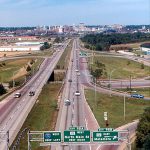U.S. engineering standards open door for new bike lane designs
Last month, a little-known group with a gigantic acronym — the Bicycle Technical Committee of the National Committee on Uniform Traffic Control Devices (NCUTCD-BTC) — voted to endorse a set of 11 devices that include bike boxes, contraflow bike lanes, and bike lanes through intersections.
Cyclists nationwide cheered the vote because of its long-term implications. As the formal advisory committee to the Federal Highway Administration (FHWA), NCUTCD and its subcommittees offer opinions on revisions to the FHWA’s Manual of Uniform Traffic Control Devices (MUTCD), the definitive guide for all traffic-control devices. The FHWA has warned that noncompliance with the MUTCD can result in the loss of federal funding, as well as greatly increase tort liability.

Bicycle lanes remain underregulated nationally, with few engineering standards or best practices established by any federal authority. From Paul Krueger.
As a result, transportation departments across the country have been loathe to use traffic control devices (like signs) that aren’t officially part of the MUTCD, one reason many cities don’t include street treatments such as bike signals, which the MUTCD currently classifies as “experimental,” in their transportation networks.
But the subcommittee’s recommendations bring such improvements closer to being included in the MUTCD, good news for cities and cycling advocates interested in incorporating bike designs into their streets systems. “It will help traffic engineers in those cities sleep easier at night knowing that the treatment is officially approved,” Darren Flusche, policy director at the League of American Bicyclists, told the press last year.
That approval would hopefully make bike safety designs more widespread, with smaller towns and cities perhaps more likely to adopt their use. Larger cities such as San Francisco, New York, and Portland, OR, have already folded the designs into their transportation systems.
Nothing is set in stone yet, however. For final approval to occur, the new guidelines must be subject to a rule-making period. Two groups—the American Association of State Highway and Transportation Officials, as well as the Institute of Transportation Engineers—review the proposed guidelines during that time, which could stymie their passage because both organizations have historically been opposed to change.
For the time being, cyclists and their supporters are celebrating the vote, which has been a long time in the making. Wrote James Wilson, executive director of nonprofit Bike Delaware, on his organization’s blog earlier this month, “. . . after seeming to move at a glacially slow pace for many years with regard to the adoption of new bicycling-related traffic control devices . . .the committee did good at their last meeting, and deserves our thanks.”
Related Posts
Category: Regulations

















